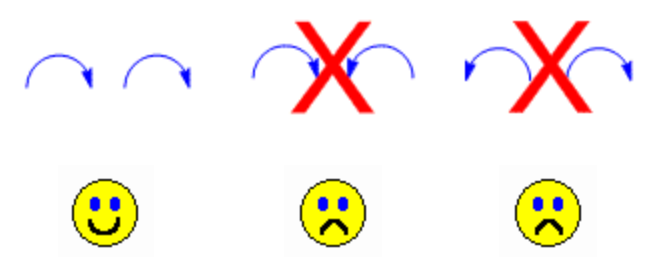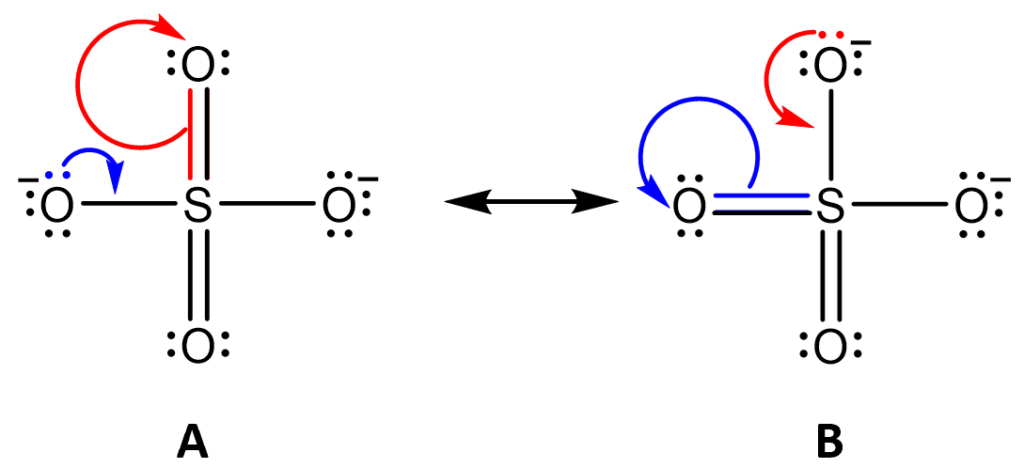A curved or curly arrow(s) shows the movement of electron(s) within or between structures.
There are two different types of arrows one can draw:
- If the arrow has both sides of its arrowhead like:
 it is showing the movement of two electrons (also called an electron pair).
it is showing the movement of two electrons (also called an electron pair). - If the arrow has only a single side of it’s arrowhead like:
 it is showing the movement of a single electron (also called a radical).
it is showing the movement of a single electron (also called a radical).
The movement of an electron pair (2 e-s) is a lot more common than the movement of a radical (1 e-). Therefore in first-year chemistry, one will usually only see double-headed arrows moving two electrons. Because of this, the rest of this page will focus on double-headed arrows and the movement of electron pairs (to learn more about radical chemistry please click here [link coming soon]).
Since an arrow is looking at the movement of electrons, the arrow starts at where the electrons are initially and then points at where the electrons will end up, just like if you were getting directions with either google maps or apple maps, it is showing the route the electrons are taking within or between molecules.
If you are following the textbook in a suggested chronological order for your course, you should have already seen a brief introduction to these arrows when doing practice questions on Lewis. One will use these arrows in multiple ways the most common ways in first-year are:
- To show bond formation when going through the steps to get to a correct Lewis structure (seen previous [link]).
- To show electrons moving between resonance structures [link].
- To show electrons moving in a reaction [link].
Each of the links above will take you into more details on that specific use for using curved/curly arrows but before clicking on one of these links it is important to overview what is common with all these scenarios.
In Resonance a double-headed arrow will usually show a:
- lone pair moving to form a bond:

- bond moving to form a lone pair:

In a reaction, we can see the above arrow pushing that we see commonly see in resonance but we can also see bonds being made:

Or broken:

When moving electrons in either resonance or a reaction electrons will only ever move in a single overall direction.

Usually, this direction is left to right (as seen above), but it can be right to left. We can also see that electrons move to the right and up or down and to the left as shown below with the resonance structures A and B of SO42-:

In the above image, it is a little harder to see that electrons are moving in a single overall direction as the direction is not directed to the right or left but is on an angle. The arrows still match the smiley face image above and not either of the sade face images.
The movement of electrons in SO42- above is colour coordinated. The blue lone pair on the left oxygen in A moves to form a double bond between O and S, so O-S becomes O=S. In order to maintain a formal charge of zero on S, another S=O double bond is converted to a single bond with the red arrow. The arrows in the right structure B show the electrons moving back to their original position in A.
If these above few examples of arrow pushing make sense then you should be able to understand almost all arrow pushing, as it is usually a repeat of one of the above examples.
Key things to keep in mind with arrow pushing:
- Arrows show the movement of electrons, not atoms, therefore an arrow always starts at either a bond or a lone pair.
- Electrons cannot fly through space, they will only move a small distance:
- Therefore an arrow starting above a lone pair pointed at the atom next door will say a bond is forming between those two atoms.
- Electrons from a bond can only become a lone pair on one of the two atoms that were initially part of the bond.
- When electrons are moving in arrows we have to recalculate formal charges as a movement in electrons will change bonding patterns and may change formal charges on atoms.
- Electrons move from regions of high electron density to low electron density (more examples of this in arrow pushing in reaction mechanisms [link])